July 30, 1927
Los Angeles and its crime ridden suburbs
This has been a mad, felony fueled day in the Southland, and there isn’t even a full moon! We have four tales of crime including a beating, triple poisoning, robbery and assault, and finally the murder of a policeman in Arcadia by three wayward youths. Read them at your leisure, or devour them all at once.
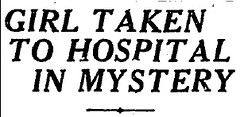
A severely beaten woman was dropped off at Culver City Hospital by three men, who then sped away. The victim’s identity has not been confirmed, but she is believed to be Vivian Edwards of 501 S. Rampart. The injured woman lapsed in and out of consciousness. Finally in a moment of lucidity, she said that she had been assaulted by a man named Dick Burk. No trace of her alleged assailant has been found. The young woman’s injuries are critical and it is feared that she may die.
*******
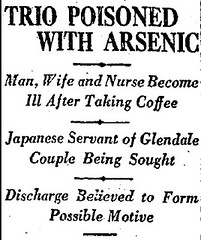
In Glendale, a wealthy couple, Mr. and Mrs. Leroy Armstrong and their nurse, Mrs. M. Woolf, are recovering in the Armstrong’s home at 1311 Rossmoyne, after having been poisoned with arsenic. The couple’s servant, Ray Tayama, is being sought in connection with the crime. The missing domestic had been discharged by Mr. Armstrong earlier in the afternoon, and as a farewell gesture Tayama served the three people coffee laced with arsenic and then vanished.
*******
Are these the only cases from the police blotter today? Don’t be ridiculous! The mayhem continues…
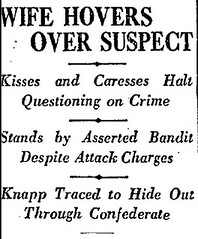
Ex-con and bail jumper Paul Knapp spent the day in the arms of his lovely wife Josephine, while she tenderly patted his cheek and vociferously declared his innocence of robbery and assault. Josephine may be confident that her husband is guiltless of the charges against him, but his record speaks persuasively to a life of crime.
declared his innocence of robbery and assault. Josephine may be confident that her husband is guiltless of the charges against him, but his record speaks persuasively to a life of crime.
Paul was a cop in Seattle from 1919 until 1923 when he was dismissed for being absent without leave, refusal to obey orders, and for participating in a liquor hi-jacking. He was busted in Los Angeles in 1924 for attacking a woman, but he fled before he could be tried. By 1925 he was in Portland doing fifteen months in McNeil Island Federal pen for impersonating a Federal officer.
In April of this year, after vowing to shoot it out with the law, he was cornered by police and wounded in the shoulder. He was booked on suspicion of robbery and as a fugitive from justice. As if those charges weren’t enough, he was also wanted in Seattle for jumping bail and in Portland for violation of the Mann Act!
Earlier this month, a court order allowed the bandit to be released into the custody of two deputy sheriffs so that he could visit a dentist – whose office was conveniently located across the street from his mother’s house. Paul asked his custodians if he could be allowed to use the bathroom at his mother’s place. The police acquiesced, and once inside the 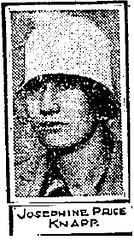 house the bandit’s cagey spouse and his wily mother engineered his escape through a trap door in the closet of the home, while the clueless officers continued to wait for him outside!
house the bandit’s cagey spouse and his wily mother engineered his escape through a trap door in the closet of the home, while the clueless officers continued to wait for him outside!
Following his escape, Paul and Josephine reunited and hid out in a small apartment at 1057 South New Hampshire which had been rented for them by an accomplice known to police. On a hunch, Detective Lieutenant Hull of the Central Police Station investigated and found Paul and his wife at the apartment. The couple’s crime partner is being hunted.
Paul’s mother and his wife have been accused of conspiracy for engineering his Houdini-like escape. A glimpse into the future finds Paul sentenced to from sixteen years to life in the state pen. His mother and his wife will seek probation, but no word if they’ll be successful.
*******
Had enough crime yet? Neither have we…
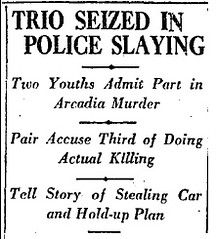
Our final story for this summer day in July of 1927 is a tale of flaming youth and flaming guns! 
Under arrest for car theft and the murder of Arcadia police officer Alfred Mathias are: Frank Miller, 18 years of age, 820-1/2 West Third Street, accused of the actual slaying; Ray Oddell, 18, Fourth and Beaudry streets, confessed driver of the get away car and Miller’s accuser. Also in custody is William Montfort, 21, 903 West Fifty-ninth Drive who admitted to have been along for the ride, but claimed to be ignorant of his two companion’s hold-up plans.
 The three boys have been friends since meeting in the State reform school at Ione. Both Oddell and Montfort credit Miller with being the brains of the outfit and insist it was he who formed the plan to rob a barbeque stand in Arcadia, which resulted in the shooting death of Officer Alfred Mathias.
The three boys have been friends since meeting in the State reform school at Ione. Both Oddell and Montfort credit Miller with being the brains of the outfit and insist it was he who formed the plan to rob a barbeque stand in Arcadia, which resulted in the shooting death of Officer Alfred Mathias.
The boys were sitting in the stolen automobile when they were approached by Officer Mathias. The cop asked Oddell for the car’s registration. Miller spoke from the back seat and told the officer he had the pink slip. Mathias thought the young man was acting suspiciously and asked “what are you sitting on?” Frank whipped out his gun and demanded that the officer “stick ‘em up”. Mathias bolted and headed for the rear of the car as Frank fired, leaving the policeman dead in the parking lot. 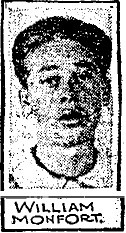
Set the time machine for two months hence; September 1927. Frank Miller will plead guilty to murder and auto theft and will be found guilty. He’ll be lucky. The jury will recommend that the youth not hang, but rather spend one year to life in San Quentin. Frank’s partners in crime Ray Oddell and William Montfort, will face similar fates.
The flaming youths burned out…and so have we! What a day!
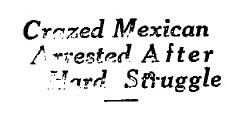

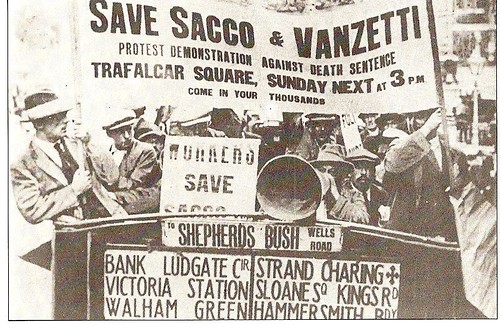 Whether or not the men were guilty of robbery and murder remains a topic for debate. What is certain is that their case was the culmination of the first so-called “Red Scare” which began amid the violence, chaos, and political unrest circling the globe during World War I.
Whether or not the men were guilty of robbery and murder remains a topic for debate. What is certain is that their case was the culmination of the first so-called “Red Scare” which began amid the violence, chaos, and political unrest circling the globe during World War I. 
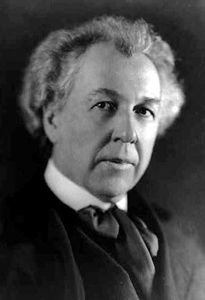
 August 26, 1927
August 26, 1927
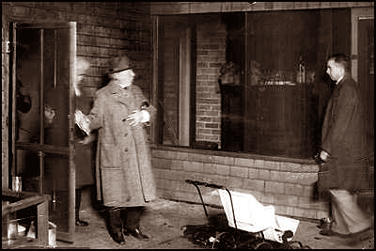
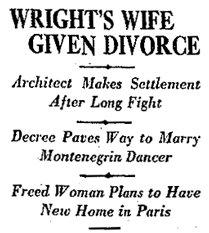 The lucky Wright-drama followers of 1927 were treated to tales of Frank and Miriam’s divorce. Today, Miriam was awarded $6,000 ($66,179 USD2006) immediately, $30,000 (330,889) in trust, and $250 (2,757) a month for life. The cash settlement and Wright’s promise that he "would lead a moral life" preceded the court decree.
The lucky Wright-drama followers of 1927 were treated to tales of Frank and Miriam’s divorce. Today, Miriam was awarded $6,000 ($66,179 USD2006) immediately, $30,000 (330,889) in trust, and $250 (2,757) a month for life. The cash settlement and Wright’s promise that he "would lead a moral life" preceded the court decree.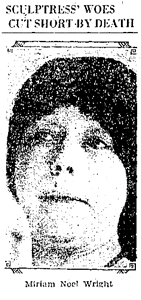 into FLW’s rented La Jolla home while he’s up in Los Angeles: “So thorough was the wrecking that the colored maid in charge of the house in Wright’s absence collapsed from the shock and was taken to the Scripps Memorial Hospital. ‘About fifteen minutes more and I would have leveled the place,’ Mrs. Wright is said to have told police when arrested…damage to the La Jolla home is estimated at about $1000…Mrs. Wright smiling pleaded guilty and following the court action, swore out complaints against her husband and Olga Hinzenberg, also known as Olga Milanoff, charging them with being lewd and dissolute persons.”
into FLW’s rented La Jolla home while he’s up in Los Angeles: “So thorough was the wrecking that the colored maid in charge of the house in Wright’s absence collapsed from the shock and was taken to the Scripps Memorial Hospital. ‘About fifteen minutes more and I would have leveled the place,’ Mrs. Wright is said to have told police when arrested…damage to the La Jolla home is estimated at about $1000…Mrs. Wright smiling pleaded guilty and following the court action, swore out complaints against her husband and Olga Hinzenberg, also known as Olga Milanoff, charging them with being lewd and dissolute persons.” 
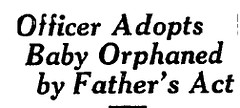 One August night in 1927, Edgar Burnett of Van Nuys shot his wife, then turned the gun on himself, leaving their four children orphaned. The children were separated, and taken in by different families. Eleanor Ray Burnett, 7, was adopted by a wealthy Anaheim family; Ermie Jean, 3, was sent to Toronto to live with Miss Myrtle Hendrie; and Edgar Jr., 16 months, went to a Van Nuys family.
One August night in 1927, Edgar Burnett of Van Nuys shot his wife, then turned the gun on himself, leaving their four children orphaned. The children were separated, and taken in by different families. Eleanor Ray Burnett, 7, was adopted by a wealthy Anaheim family; Ermie Jean, 3, was sent to Toronto to live with Miss Myrtle Hendrie; and Edgar Jr., 16 months, went to a Van Nuys family.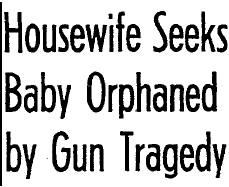 Shandra had recently served 30 days for beating his wife, Carmela, who had moved into her own place while Shandra was in jail. He went to the apartment at 808 E. Palmer Ave., Glendale, and shot Carmela to death with a rifle in front of the couple’s 2-year-old son, Bobby. Then, Shandra went into another apartment in the building, and killed himself.
Shandra had recently served 30 days for beating his wife, Carmela, who had moved into her own place while Shandra was in jail. He went to the apartment at 808 E. Palmer Ave., Glendale, and shot Carmela to death with a rifle in front of the couple’s 2-year-old son, Bobby. Then, Shandra went into another apartment in the building, and killed himself.


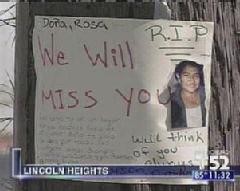

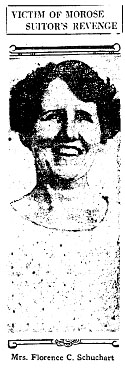
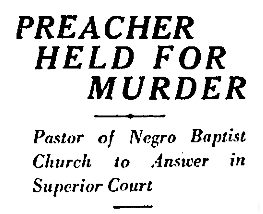

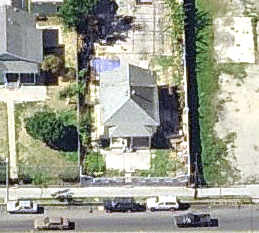 Of the two things a pastor can draw from his waistband—his bible or his revolver—Rev. Hardy elected to draw the latter. He shot Dianty in the abdomen, and when Dianty turned the other cheek (to run away) Hardy shot him again in the neck and shoulder. Dianty died on the sidewalk.
Of the two things a pastor can draw from his waistband—his bible or his revolver—Rev. Hardy elected to draw the latter. He shot Dianty in the abdomen, and when Dianty turned the other cheek (to run away) Hardy shot him again in the neck and shoulder. Dianty died on the sidewalk.



 declared his innocence of robbery and assault. Josephine may be confident that her husband is guiltless of the charges against him, but his record speaks persuasively to a life of crime.
declared his innocence of robbery and assault. Josephine may be confident that her husband is guiltless of the charges against him, but his record speaks persuasively to a life of crime. house the bandit’s cagey spouse and his wily mother engineered his escape through a trap door in the closet of the home, while the clueless officers continued to wait for him outside!
house the bandit’s cagey spouse and his wily mother engineered his escape through a trap door in the closet of the home, while the clueless officers continued to wait for him outside! 

 The three boys have been friends since meeting in the State reform school at Ione. Both Oddell and Montfort credit Miller with being the brains of the outfit and insist it was he who formed the plan to rob a barbeque stand in
The three boys have been friends since meeting in the State reform school at Ione. Both Oddell and Montfort credit Miller with being the brains of the outfit and insist it was he who formed the plan to rob a barbeque stand in 

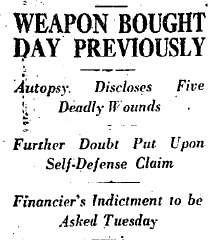
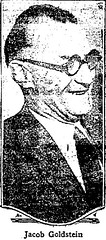 Joseph Stern, by bashing him four times over the head with a hammer and firing three bullets from a revolver into his body. It would have been less messy if only Goldstein had let an attorney handle the dissolution.
Joseph Stern, by bashing him four times over the head with a hammer and firing three bullets from a revolver into his body. It would have been less messy if only Goldstein had let an attorney handle the dissolution.